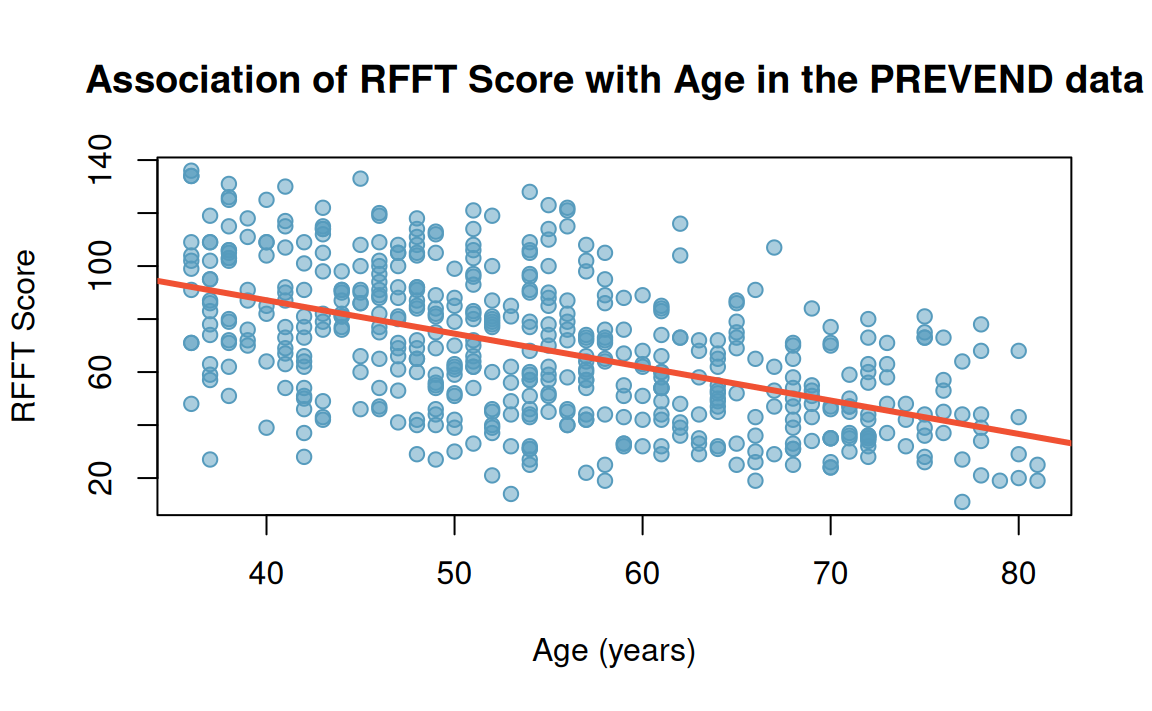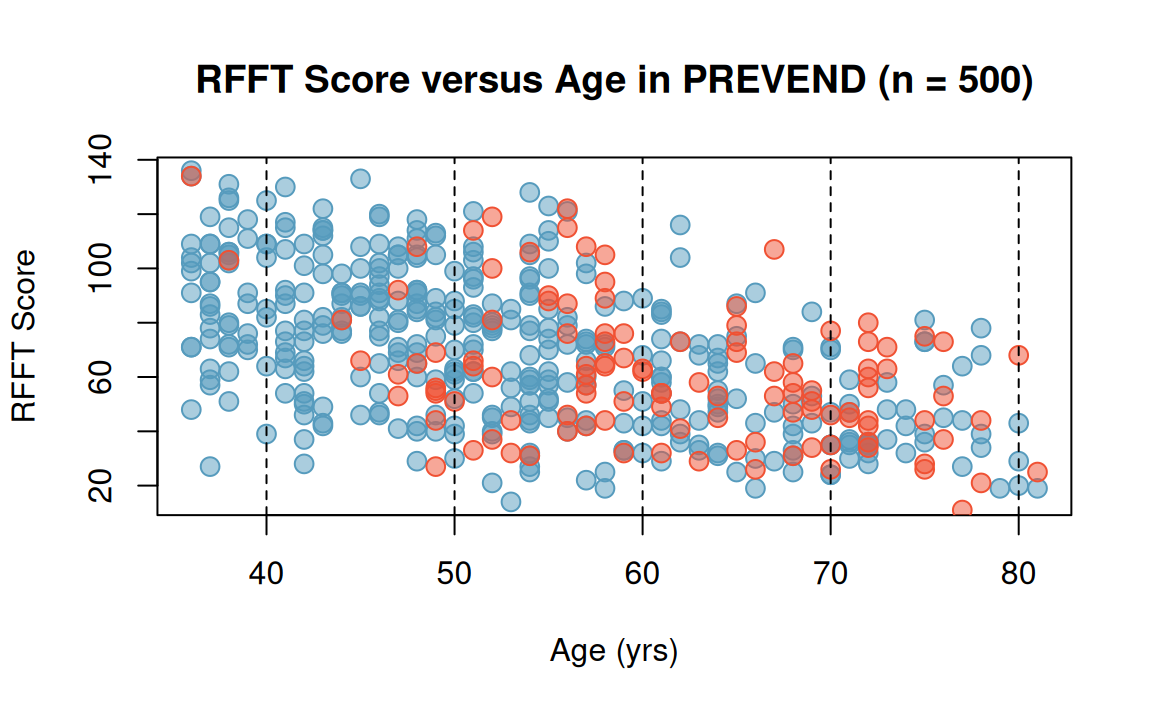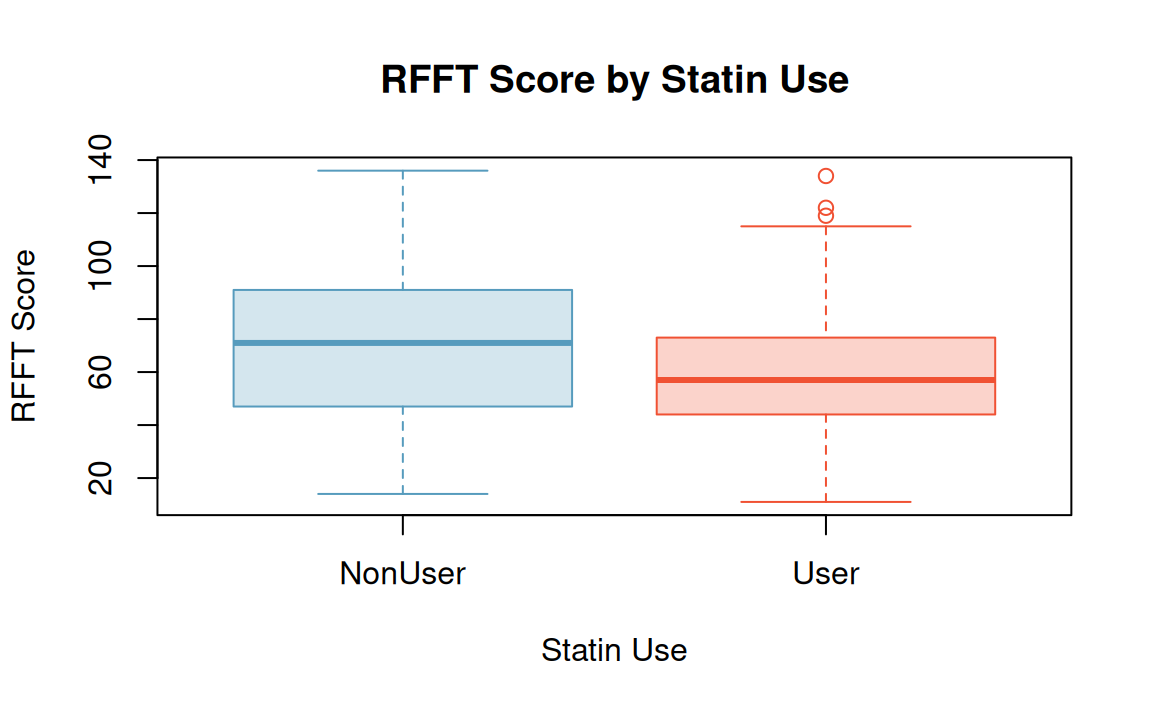
Introduction to Linear Regression
September 3, 2025
Regression
Regression methods examine the association between a response variable and a set of possible predictor variables (covariates).
- Linear regression posits an approximately linear relationship between the response and predictor variables.
- The response variable
- A simple linear regression model takes the form:
Simple linear regression quantifies how the mean of a response variable
Multiple regression
Multiple linear regression evaluates the relationship, assuming linearity, between the mean of a response variable,
This is conceptually similar to the simpler case of evaluating
Linearity is an approximation; so, think of regression as projection onto a simpler worldview (“if the phenomenon were linear…”).
Back to the PREVEND study
As adults age, cognitive function changes over time, largely due to cerebrovascular and neurodegenerative changes. PREVEND study measured clinical, demographic data for participants, 1997-2006.
- Data from 4,095 participants appear the
prevenddataset in theoibiostatRpackage. - Ruff Figural Fluency Test (RFFT) to assess cognitive function (planning and the ability to switch between different tasks).
Assumptions for linear regression
A few assumptions for justifying the use of linear regression to describe how the mean of
- Independent observations:
- Linearity:
- Constant variability (homoscedasticity): variability of response
- Approximate normality of residuals:
What happens when these assumptions do not hold? 🤔
Linear regression via ordinary least squares
Distance between an observed point
For
The least squares regression line minimizes the sum of squared residuals1
The mean squared error (MSE), a metric of prediction quality, is also based on the residuals
Coefficients in least squares linear regression
Linear regression: The population view
For a population of ordered pairs
Since
So, the regression line is a statement about averages: What do we expect the mean of
Linear regression: Checking assumptions?
Assumptions of linear regression are independence of study units, linearity (in parameters), constant variability, normality of residuals.
- Independence should be enforced by well-considered study design.
- Other assumptions may be checked empirically…but should we?
- Residual plots: scatterplots in which predicted values are on the
- Normal probability plots: theoretical quantiles for a normal versus observed quantiles (of residuals)
- Residual plots: scatterplots in which predicted values are on the
Linear regression with categorical predictors
Although the response variable in linear regression is necessarily numerical, the predictor may be either numerical or categorical.
Simple linear regression only accommodates categorical predictor variables with two levels1.
Simple linear regression with a two-level categorical predictor
Back to FAMuSS: Comparing ndrm.ch by sex
Let’s re-examine the association between change in non-dominant arm strength after resistance training and sex in the FAMuSS data.

Female Male
62.92720 39.23512 (Intercept) famuss$sexMale
62.92720 -23.69207 - Intercept
- Slope
Strength of a regression fit: Using
- Correlation coefficient
- If a linear regression fit perfectly captured the variability in the observed data, then
- The variability of the residuals about the regression line represents the variability remaining after the fit;
Statistical inference in regression
Assume observed data
Under this assumption, the slope
Goal: Inference for the slope
Hypothesis testing in regression
The null hypothesis
Use the
Confidence intervals in regression
A
Example: Linear Regression in an RCT
Consider a randomized controlled trial (RCT) that recruits
| L1 | L2 | X | Y |
|---|---|---|---|
| 1 | 1 | 0 | 1.39 |
| 0 | 0 | 0 | -0.18 |
| 0 | 0 | 0 | -0.20 |
| 1 | 1 | 1 | 3.61 |
The treatment
Statistical power and sample size
Question: A collaborator approaches you about this hypothetical RCT, wondering whether
In terms of hypothesis testing:
The power of a statistical test is the probability that the test (correctly) rejects the null hypothesis
- the hypothesized effect size (
- the variance of each of the two groups (i.e.,
- the sample sizes of each of the two group (
Outcomes and errors in testing
| Result of test | ||
|---|---|---|
| State of nature | Reject |
Fail to reject |
| Type I error, |
No error, |
|
| No error, |
Type II error, |
Choosing the right sample size
Study design includes calculating a study size (sample size) such that probability of rejecting
It is important to have a precise estimate of an appropriate study size, since
- a study needs to be large enough to allow for sufficient power to detect a difference between groups when one exists, but
- not so unnecessarily large that it is cost-prohibitive or unethical.
Often, simulation is a quick and feasible way to conduct a power analysis.
Multiple regression
In most practical settings, more than one explanatory variable is likely to be associated with a response.
Multiple linear regression evaluates the relationship between a response
Multiple linear regression takes the form
PREVEND: Statin use and cognitive function
The PREVEND study collected data on statin use and demographic factors.
- Statins are a class of drugs widely used to lower cholesterol.
- Recent guidelines for prescribing statins suggest statin use for almost half of Americans 40-75 years old, as well as nearly all men over 60.
- A few small (low
Age, statin use, and RFFT score

Red dots represent statin users; blue dots represent non-users.

Call:
lm(formula = RFFT ~ Statin, data = prevend.samp)
Coefficients:
(Intercept) StatinUser
70.71 -10.05 Interpretation of regression coefficients
Multiple (linear) regression takes the form
Recall the correspondence of the regression equation with
The coefficient
Practically, a coefficient
In action: RFFT vs. statin use and age
Fit the multiple regression with lm():
# fit the linear model
prevend_multreg <- lm(RFFT ~ Statin + Age, data = prevend.samp)
prevend_multreg
Call:
lm(formula = RFFT ~ Statin + Age, data = prevend.samp)
Coefficients:
(Intercept) StatinUser Age
137.8822 0.8509 -1.2710 Assumptions for multiple regression
Analogous to those of simple linear regression…
- Independence: units
- Linearity: for each predictor variable
- Constant variability:
- Normality of residuals:
References

HST 190: Introduction to Biostatistics